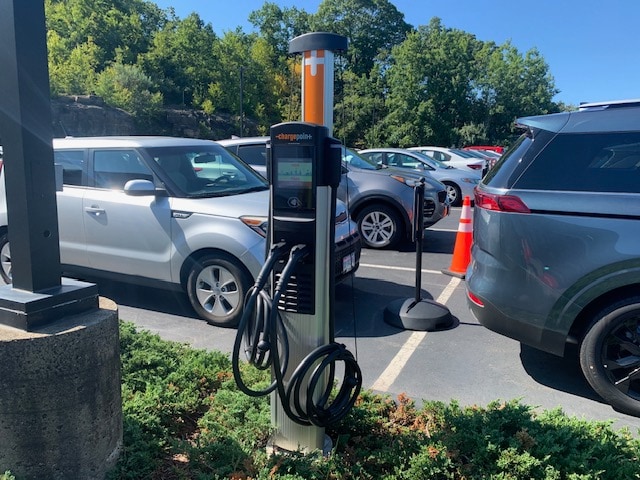Premier Kia is proud to have 3 EV chargers at our Dealership. Our outside charger is available 24 hours per day. Outside charger is a level 2. Located directly opposite glass Service bay. Under light pole.
Types of Electric Car Charging Stations
Currently, there are four types of plugs in use on electric vehicles: type 1 is a single-
phase coupler, type 2 is a single- and three-phase coupler, type 3 is a single- and
three-phase coupler equipped with special shutters for increased safety, while type 4
is a fast charger coupler used by specific charging networks.
In terms of charging speed, the electric car charging stations available today can be
slow, fast and rapid. Here are some of the most important features of each type:
- Slow units can take up to 8 hours to charge the EV, therefore they are most common for home use or for charging the car parked in the street overnight. In most homes, the installation of a home charging station requires the installation of special circuitry and cables. Though most slow chargers use standard 3-pin sockets, the high current demand of the charging process requires special circuitry to be installed in the home for making usage safe;
- Fast chargers take much less, usually 3-4 hours to fully charge an EV. Most of these units are located in the parking lots of supermarkets, of office buildings or of other, similar facilities, and they allow EV owners to plug their cars while using the services offered by the facilities or while they are at work;
- Rapid chargers – the most efficient electric car charging stations available today use either alternating or direct current. Usually rated at 40-50 kW, these rapid stations can charge an EV battery to 80% in 30-60 minutes. There are stations that are even stronger, rated at over 100 kW, able to charge an EV in 10-30 minutes. Rapid chargers can be used by EV that have rapid charging capabilities and are equipped with special connectors.
Plugging the car to charge is not the only way to get the energy needed by EVs for
moving on. The solution called battery swapping or battery switching is also
becoming increasingly popular. The process takes place at battery swapping stations
and it involves the removal of the depleted battery from the car and its replacement
with a fully charged battery. Battery swapping is offered for many makes and models,
allowing EV drivers to get their car battery replaced without even having to get out of
their cars and to be back on the road in a few minutes.
History of Electric Car Charging Stations
The electric vehicle and the electric car charger were invented in 1830, but theirpopularity started to increase only in the 1950’s, when a technology very similar to
the one used on the initial cars was implemented on spacecrafts. The next important
event in the evolution of electric car chargers was the launch of the Toyota Prius in
1997, the auto maker’s iconic EV that has initiated the change in the way that the
general public viewed electric vehicles. The Prius was followed by Tesla’s
spectacular luxury car in 2006 and, since then, almost all major auto makers released
network size. Today, there are over 18,000 electric car charging stations in the US.
Initially, the network included EV charger units located at filling stations or stand-
alone, distributed across the country. Then, as the demand increased, chargers
became available for home use, on workplace premises, and at supermarkets, dealerships and shopping centers.
The Future of Electric Car Charging Stations
The evolution of electric car charging stations is likely to continue in the direction ofwider availability, speed and efficiency. Tesla already has a network of
Superchargers that are rated at over 100 kW, and such powerful units will probably
become more and more widespread in the following years. Slower stations are also
likely to become more widespread, enabling electric vehicle owners to use their cars
even for long road trips, giving them the peace of mind that they will surely find a
suitable charging station before their car’s battery depletes. Research is carried on to
improve electric vehicle technology in the direction of increased autonomy – modern
EVs can cover up to 200 miles on a single charge, some of them even more, and
